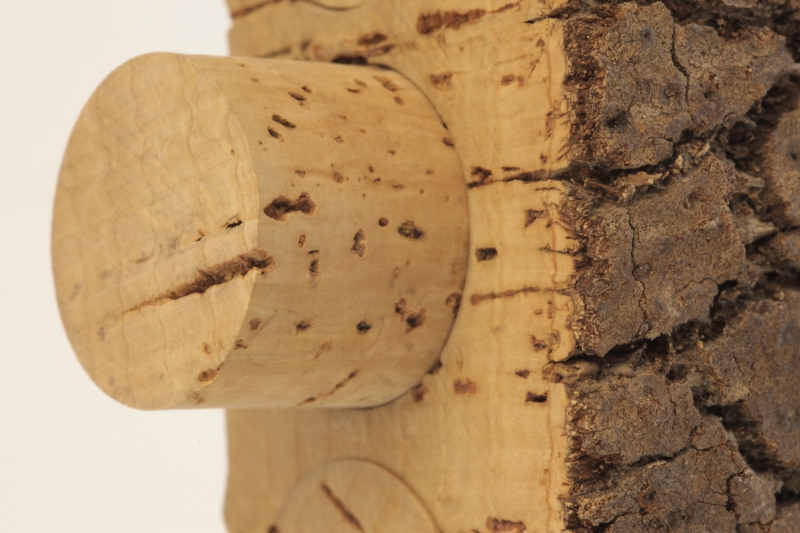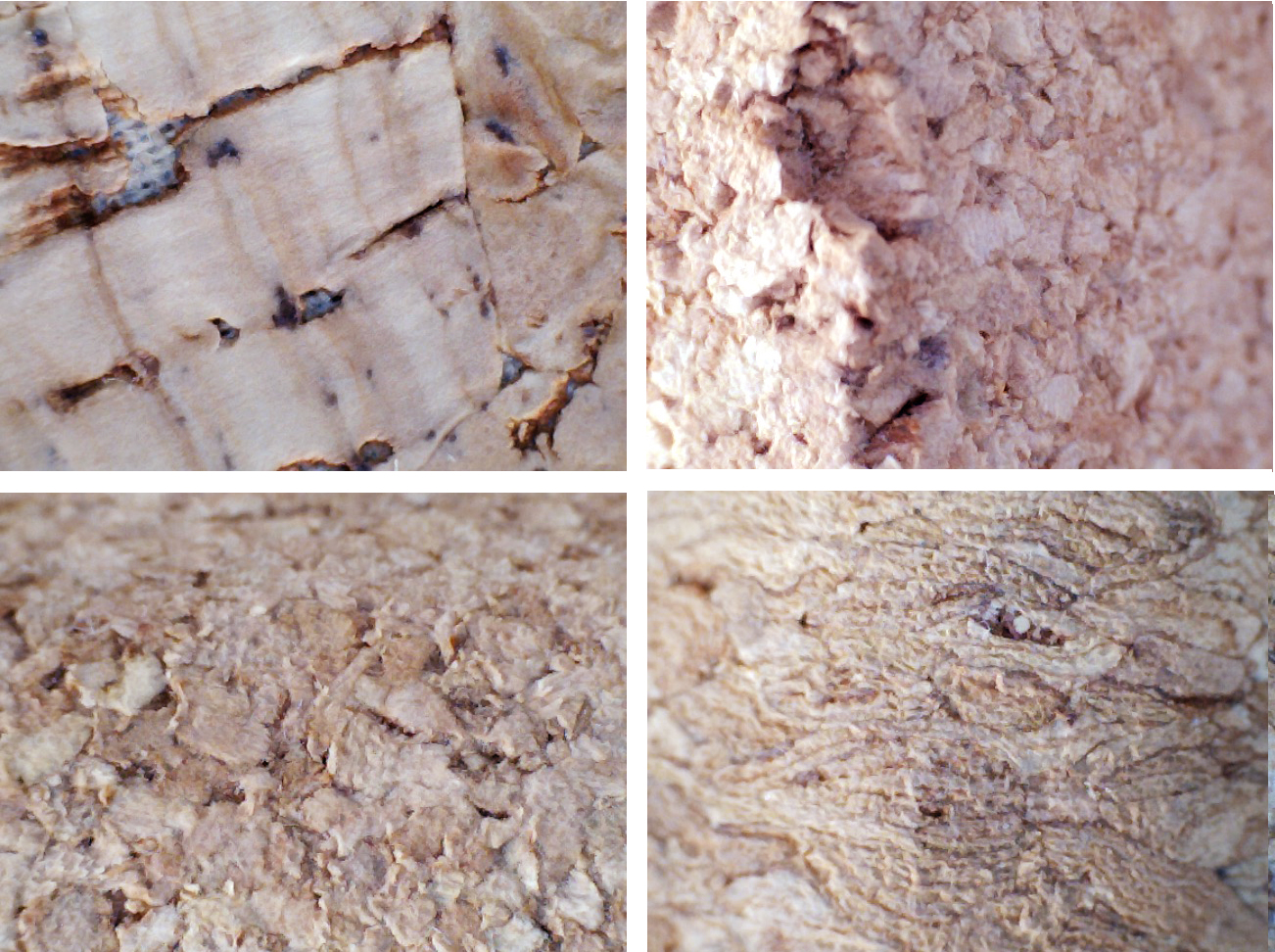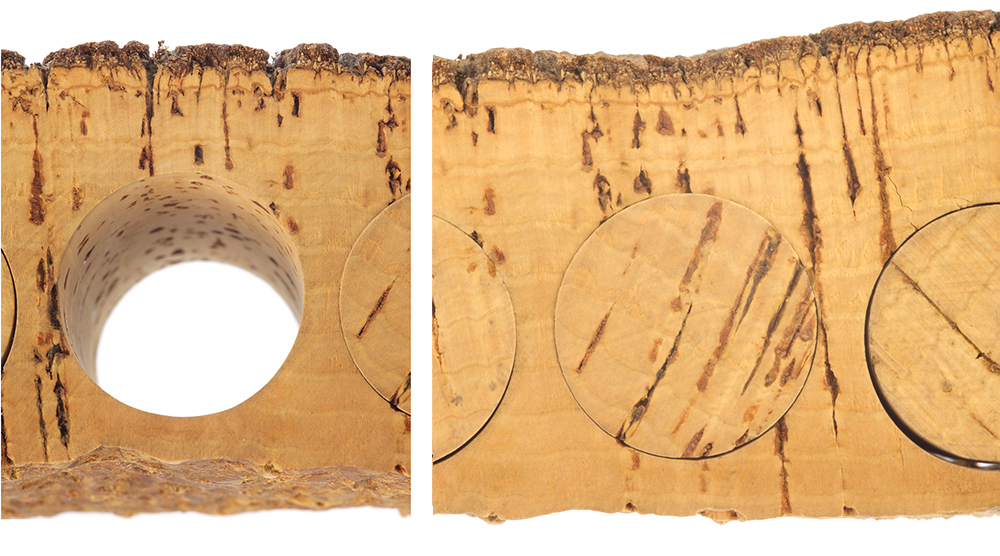Materials Up Close & Personal: CORK
04 June 2020

This characterful, warm and tactile Mediterranean material may be most familiar as the chewy, beige bung that stands in between you and a glass of wine, the insulating coaster that stops your hot tea from cracking a varnished table, or the bulletin board where you pin up that important reminder to feed the neighbour’s cat. Without it we would be a sober, heat-crazed and forgetful bunch!
But cork’s versatile repertoire also spans applications as varied as life jackets, fishing floats, anti-ageing creams and orthopaedic shoes. What’s more, cork oak acorns make an excellent foodstuff for goats, and are particularly beloved by Spanish pigs, contributing to the sweet flavour of Iberico ham. In this week’s up-close material exploration, we pop open this cork-er of a material, delving into its long history of quiet competence.
Cork is the bark of the cork oak tree (Quercus suber); a slow-growing, long-lived oak that mainly grows in the savannahs of southwest Europe and north Africa. All trees have a thin layer of cork in their bark, developed as an adaptation to protect against fires, but in this particular oak it grows to form layers up to thirty centimetres thick. The cork oak tree can live for up to 250 years, whilst the material we know and love is skilfully harvested from the stem every nine years or so, without harming the tree. This renewable, spongy coat has a honeycomb structure that consists of billions of tiny, hollow, pentagonal or hexagonal cells. The cell walls are made from a fatty biopolymer called suberin (which is also responsible for the tough skin and long storage life of the potato) and are filled with an air-like gas that makes up 90% of the material’s volume. This waxy, hollow, honeycomb structure gives cork its unusual array of properties: impermeability to liquids and gases, strength and light weight, flexibility, compressibility and excellent thermal and acoustic insulation.

These extraordinary properties are revealed by cork’s long catalogue of uses from antiquity to today. For example, Roman soldiers made the most of cork's ability to thermally insulate by using it in their helmets to protect them from the sun, and small Roman women are thought to have made the most of its strength, light weight and compressibility by fashioning some of the earliest platform shoes. It’s still employed in wearable items today in the soles of Birkenstocks and combined with cloth to make everything from couture handbags to neck ties. Cork’s architectural career also began with the Romans, when it was used as insulating roof covering. Fast-forwarding to today, it features domestically in the form of linoleum flooring (whose retro charms are thanks to a composite of cork, oxidised linseed oil and gum pressed onto flax sheets). On the international stage cork played star roles in Ai Wei Wei and Herzog & de Meuron’s 2012 Serpentine Pavilion, Superflex’s 2018 installation of a forest of cork swings in the turbine hall at Tate Modern, and most recently, an entirely cork house that was designed and prototyped here at UCL’s Bartlett School of Architecture.
Cork’s water-repelling tendencies, floating power and durability make it ideal for marine applications where buoyancy is vital. The trustworthy and uplifting natural foam was first used in 3000 BC for early Chinese fishing floats, and was still in service at the end of the 1700s, surpassing rivals such as horse hair and balsa wood to become the filling for the first life jackets. Cork has long-proven its worth to sailors and naval types, finding use as floating marker for the position of an anchor, as ‘tampions’ to stopper the barrels of guns and prevent dust and salt water getting in, and as a filling for barricades to protect against enemy fire. To this day, cork is still a favourite of fishing folk: cork bobbers slosh around on the surface to attract the fish, whilst also adding more life to the attached artificial lure dangling below. Staying on a nautical theme, let’s not forget cork’s role in conveying final farewells and romantic declarations through the iconic message in a bottle (although sadly not all missives make it to land, with one poem about the birth of a baby boy found inside the stomach of an eleven foot shark).

This brings us onto the use of cork that we are probably all most familiar with, the bottle stopper. Cork’s behaviour under compression makes it particularly well-suited to being a bung: it has what materials scientists call a ‘near-zero Poisson’s ratio’. This means that corks do not expand sideways when compressed from the top, so can be smoothly popped in and out of a bottle without deforming. Rubber, by contrast, has a high Poisson’s ratio, meaning that it swells sideways when compressed from the top, resulting in a tight-fitting rubber bung getting jammed when squashed into the neck of a bottle.
Its fatty, waxy composition also makes cork impenetrable by gases and liquids alike: perfect as a plug to seal fluids into containers and to protect them from the oxidising influence of outside air. Cork has been used this way to contain wine and oils since the Greeks replaced earlier terracotta, limestone and bone stoppers with this more resilient and elastic alternative in the 6thcentury BC. However, corks haven’t always been ubiquitous in wine production. In 17thcentury France they used wooden stoppers wrapped in hemp and soaked in oil until the rockstar winemaker of the age – Benedictine monk Dom Pierre Perignon of the Champagne region – began using cork to top his bottles of inconveniently fizzy wine. At the time, Dom Perignon considered his sparkling wine to be a production fault that needed remedying, but unlike rigid wooden bungs, which frequently popped out of Dom Pierre’s bottles, flexible cork could be compressed to properly fill the neck of the bottle and form a tight seal, resisting the explosive pressure caused by the build-up of gas. The gassy by-product that would later make this effervescent wine so popular was carbon dioxide, produced by the micro-farts of yeast feeding on sugars in the wine. Inside a contemporary bottle of champagne there can be up to ten grams of carbon dioxide, creating pressure about three times that in a car tyre, which is why the glass bottles are so thick and corks so tight-fitting.
From the 17th century onwards, cork became synonymous with wine making, and a lot of time and effort was spent perfecting the production of the highest quality cork bungs. The bark of the tree is left to dry and expand for between six months to a year before being dipped in boiling water for an hour to remove any dusts or contaminants. The highest quality bottle stoppers are then punched directly out of the best pieces of wood, and lower quality pieces of bark are shredded and used to make composite cork – the familiar beige friend that resembles compressed breadcrumbs, commonly seen in dartboards, pin boards and the (cheaper) wine corks that I normally encounter.
These cheaper composite wine corks, plastic bottle stoppers and tin screw-caps have recently begun to dominate the wine market, and a passionate debate rages amongst wine makers about whether to cork or not to cork. This is partly fuelled by the problem of ‘cork taint’ whereby some natural corks produce an extremely aromatic, mouldy and musty chemical (TCA) that is thought to be the complex result of airborne fungi chomping down on industrial pollutants in the wood (cholorophenols). The resulting chemical is so odorous that a teaspoon of it can spoil an entire year’s production of wine, so you can see why some producers shy away from cork.
In terms of protecting the wine from oxygen, tin-lined screwcaps are thought to offer the closest thing to an air-tight seal, closely followed by high quality cork. Both are thought to be superior to plastic (polyethylene) stoppers, as these less compressible synthetic materials struggle to fill imperfections in the neck of the bottle and can become brittle with age, letting air in. However, whilst a hermetic seal may be the ultimate goal for some young wines, others (particularly red grape varieties like Pinot Noir or Syrah that naturally ferment in more anaerobic conditions) may actually benefit from low levels of exposure to oxygen. The inherent breathability of cork allows for these controlled, low levels because its impermeable waxy honeycomb structure is punctuated by porous cells called lenticels that allow for the controlled exchange of gases between the inside and outside of the tree. The presence of lenticels in the structure of the cork means it is not quite a hermetic seal, and a very small amount of gas can diffuse across the cork, helping the wine to mature.
To make good on the promise of a cork account that goes beyond its use wine production, it’s time to move on to cork’s many other talents. Over the centuries, numerous claims have been made for the health benefits of cork, some of them apocryphal: the Greeks and Romans believed charred cork and laurel sap rubbed on bald patches could provide a cure for hair loss, and British folk remedies suggest that a cork under the pillow or in the pocket will keep cramp at bay (it's either that, or keeping the forefeet of a mole about your person).
There are plenty of evidence-based medicinal applications for cork extracts though, including the use of suberin to absorb carcinogenic substances from the digestive tract, and in anti-ageing skincare products where it is said to have a smoothing and tensing effect on the skin. Cork and rubber compounds have proven very useful in the manufacture of orthotic insoles, shoe-lifts and arch supports: these soft and forgiving composites can be thermo-formed, vacuum-formed, and easily adjusted with a sanding wheel. Cork bark and its products have also been shown to demonstrate natural antimicrobial activity, inhibiting the growth of Staphylococcus aureus and Pseudomonas aeruginosa, two of the bacteria that are responsible for hospital-acquired infections.
Cork has silently supported many historical scientific discoveries: Robert Hooke’s observations of cork underpinned scientific understandings of the cellular nature of plants, and cork and lead balls were used by Galileo in his experiments with pendulums. More recently, cork and water ‘phantoms’ that mimic tissue in the human body have been used to calculate safe dosages of x-rays that can be used on the lungs and thorax. Researchers are currently looking at the efficacy of using hydrophobic (water-repelling) and lipophilic (fat-loving) heat-treated cork products in the bioabsorption of pollutants, and the rather unimaginatively named ‘Corksorb’ is already being used to soak up oils and fats from industrial wastewater.

About our blog series 'Materials: Up Close & Personal'
We are publishing a new series of ten extra-long Materials Library profiles, through which our Materials Librarian Sarah Wilkes will be paying homage to those silent and humble materials that we surround ourselves with daily, but that often we don’t even notice. Every week or so, she will be exploring the expansive inner lives and backstories of the surfaces, substances and stuff around us, and sharing it with our community through our blog and social media #MaterialsLibraryUpCloseAndPersonal.
We would love you to join in too! Send us a picture of one of your favourite household substances with a few words about what you’ve noticed after spending some time getting to know your material cohabitants. We will periodically post a collection of these little gems on our website.